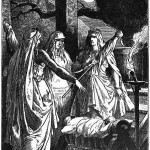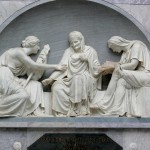 From the Gita to the Grail: Exploring Yoga Stories & Western Myth
From the Gita to the Grail: Exploring Yoga Stories & Western Myth
Reference/Yoga and Mythology
Blue River Press
1 January 2014
Hardcover
592
Publisher provided review copy

“What is the meaning of Shiva dancing on a dwarf named Avidya? Why does Vishnu sleep upon an endless snake? To what did the Buddha awaken? What do we mean by soul? The practice of Yoga has become quite common and popular in the West; however, the stories of Yoga are still strange to Western ears. What do these ancient symbols mean, what are they trying to teach us, and how should we incorporate the knowledge skillfully into our Western lifestyle? By looking at the myths of Yoga along with the stories that have influenced Western culture, we are presented with opportunities to select the best of both worlds, and create new maps to help guide us through the uncertainties of modern living.”
Bernie Clark is widely known for his teaching of Yin Yoga. This is from the YinYoga.com website:
Bernie has been teaching yoga and meditation since 1998. He has a bachelor degree in Science from the University of Waterloo and combines his intense interest in yoga with an understanding of the scientific approach to investigating the nature of things. His ongoing studies have taken him deeply inside mythology, comparative religions and psychology. All of these avenues of exploration have clarified his understanding of the ancient Eastern practices of yoga and meditation. His teaching, workshops and books have helped many students broaden their own understanding of health, life and the source of true joy.
 My father taught English; so, I grew up listening to myths around the campfire as often as tall tales about fishing.
My father taught English; so, I grew up listening to myths around the campfire as often as tall tales about fishing.  My father loved to muse over the similarities between diverse myths: Three women controlling the Fate of the world as seen in the Norns of the Norse and the Fates of the Greeks. A woman in a lake with a magical sword from Arthurian legend and from Beowulf. This influenced me to do the same with religion and philosophy and helped me to identify not merely differences, which are so easy to see, but the bridges between vastly different views. When I learned that Bernie Clark had done something similar in this book, I felt ecstatic when I was asked to review it!
My father loved to muse over the similarities between diverse myths: Three women controlling the Fate of the world as seen in the Norns of the Norse and the Fates of the Greeks. A woman in a lake with a magical sword from Arthurian legend and from Beowulf. This influenced me to do the same with religion and philosophy and helped me to identify not merely differences, which are so easy to see, but the bridges between vastly different views. When I learned that Bernie Clark had done something similar in this book, I felt ecstatic when I was asked to review it!
Reading the preface both fueled my hopes and caused me some misgivings.
While this book contains novel ideas and associations, I have made no attempt to prove any of the particular points of view, and I am not qualified to do so. The book is meant to educate and provoke thought, not to cite sources and dates.
From Gita to Grail, pg xii
Was this a promise of an author with an open mind or one who would be stating simple opinion as fact?
Occasionally, the way the stories are explained may cause some distress for readers who happen to believe that the story is factually or historically true and not a myth.
[ . . . ] It is not my intent to take away anyone’s cherished beliefs but rather to open a door that may help them go deeper in whatever direction their beliefs point them. The start is knowing that there is more to mythic or spiritual stories, and that we can shine a light on what is hidden.
[ . . . ] One last point worth making is that I have made no attempt to reproduce the original mythic stories. [ . . . ] I have tried to tell most of these old stories in a modern, folksy vernacular, not in the original, archaic verse.From Gita to Grail, pgs xii – xiii
This was starting to sound more like Bernie would be stating his opinion as fact and while I was looking forward to a true retelling of myth and story, I had to let that go completely. Still, I had hope because Bernie’s stated intention was to “open a door that may help them go deeper in whatever direction their beliefs point them.” He was going to point out similarities between these stories, show me something new about them and let me put the pieces together as to what it all meant. Not quite.
Throughout the book, folksy vernacular is largely used for stories of “God and his boys” whereas “Krishna remained steady and upbraided Arjuna” which is anything but folksy. Using folksy vernacular or traditional verse throughout would have given more continuity to the book; instead, the colloquial nature of some of the retellings felt a bit jarring.
The tone of the text leans toward discounting the myths and stories of Christianity and patriarchy while extolling the virtues of eastern myths and stories and matriarchy and goddess worship. Mr. Clark’s personal views are stated as fact, “There is no personal god judging us.” I found that my hopes were empty and my concerns valid as I continued to read. Bernie does an excellent job of showing us where to look but instead of asking us what we see, the hallmark of a great teacher, he tells us what we must see.
Why Three Stars?
With what I just wrote, you might wonder why I would still give three stars to the book. I would give it 3.5 if the rating system would let me. Bernie asks some very hard questions in this book and exposes the reader to thoughts far outside any comfort zone. Few authors have the courage to do that.
Would I recommend others read this book? Yes, it’s worth the read because it is uncomfortable and because as we ask questions about our own beliefs, our own maps as Bernie calls them, we can better see what serves us and what does not.
Jai Bhagwan
